Stitching together a family legacy
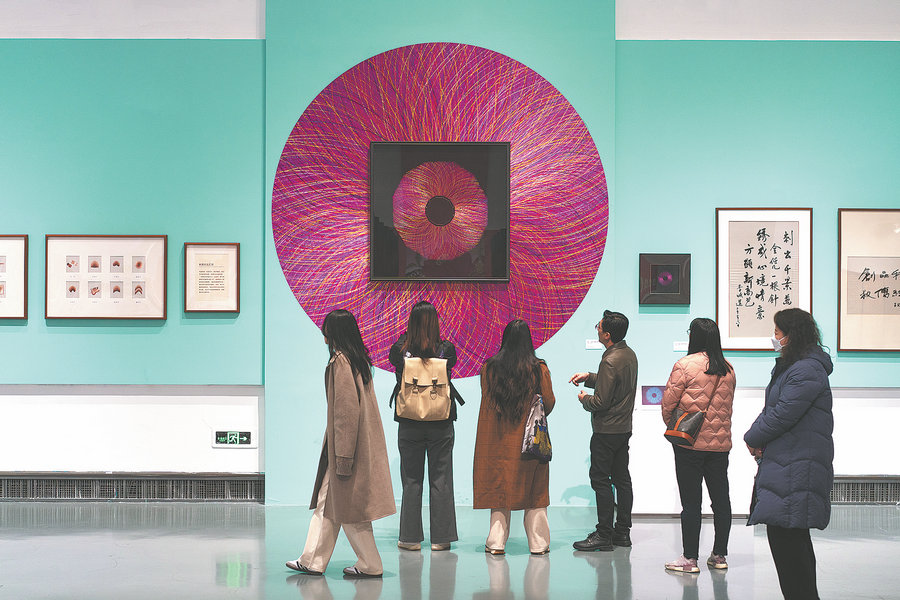
An embroidery work depicting the collision of gold nuclei is a big draw for visitors at the Suzhou Art Museum. [Photo by Gao Erqiang/China Daily]
Walking into the Suzhou Art Museum in Suzhou, Jiangsu province, the eyes of visitors are immediately drawn to an artwork hanging high on the wall that depicts the collision of gold nuclei, giving the surface impression of a contemporary art piece.
However, upon closer examination, viewers will see that the luster of its shimmering lines belies the ancient craft of Su embroidery, which originated in the city more than 2,000 years ago.
"Viewers mistake it for an oil painting at first sight. We hope to imbue the traditional craft with contemporary expressions," says Zhang Fan, 48, one of the creators of the piece.
Next to the artwork are two Su embroidery works replicating abstract photos taken by US photographer Michael Yamashita. All of these works are produced by Zhang and his mother, Zhang Meifang, 78, a master embroiderer who created the collision piece in collaboration with established physicist Tsung-dao Lee.
In 2005, the Zhangs established an embroidery innovative center, applying the ancient stitching techniques of silk thread to modern art forms, including oil paintings, murals, sculpted reliefs and photos.
Known for its intricate techniques, elegant style and vibrant colors, Su embroidery usually focuses on birds and flowers, cats, landscapes and figures. Most embroiderers in the area have concentrated on these subjects for centuries, making it popular among both the nobility and the general populace for its exquisite needlework.
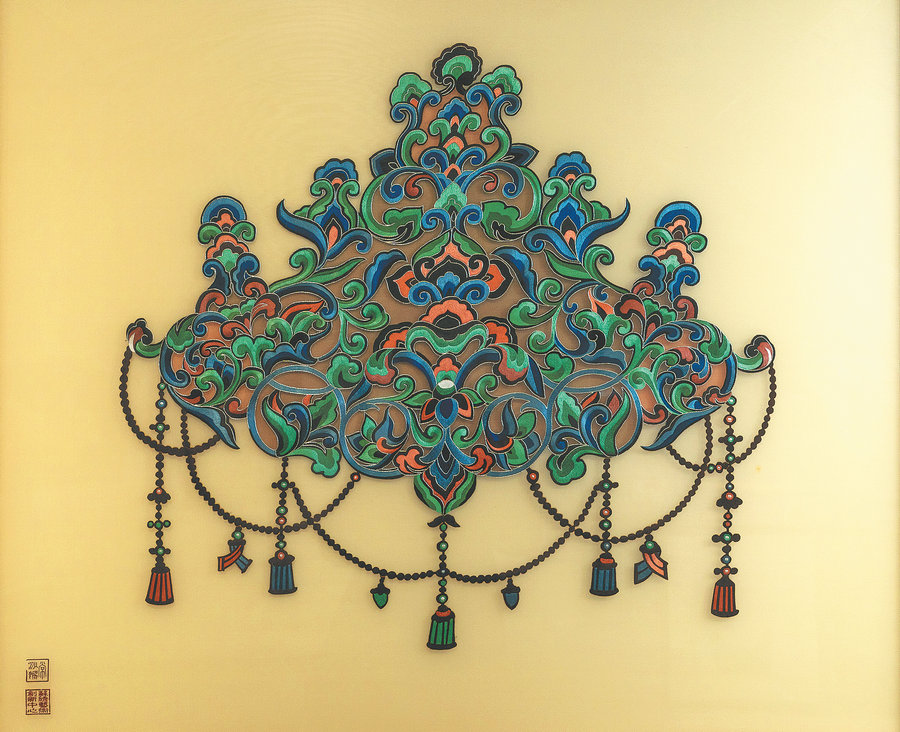
A traditional pattern made by Zhang Fan's team. [Photo by Gao Erqiang/China Daily]
To give the traditional craft a modern look, Zhang Fan and his mother spent decades on innovating the threads they used, as well as the themes. They worked with prominent artists, such as Wu Guanzhong, a Chinese modern art pioneer, and Chang Shana, an artist and renowned scholar on the studies of frescoes in Dunhuang, Gansu province, as well as foreign photographers.
The charm of Su embroidery for Zhang Fan lies in its rich and vibrantly colored silk threads, which give a luster to the patterns stitched on the fabric.
"It's an art of light. The flowers can change color when you see them from different angles. They look as if they are dancing on the breeze," says Zhang Fan.
To achieve such a magic effect, they use threads of various thickness and of different shades of a single color. For certain applications, they even create their own special silk threads.
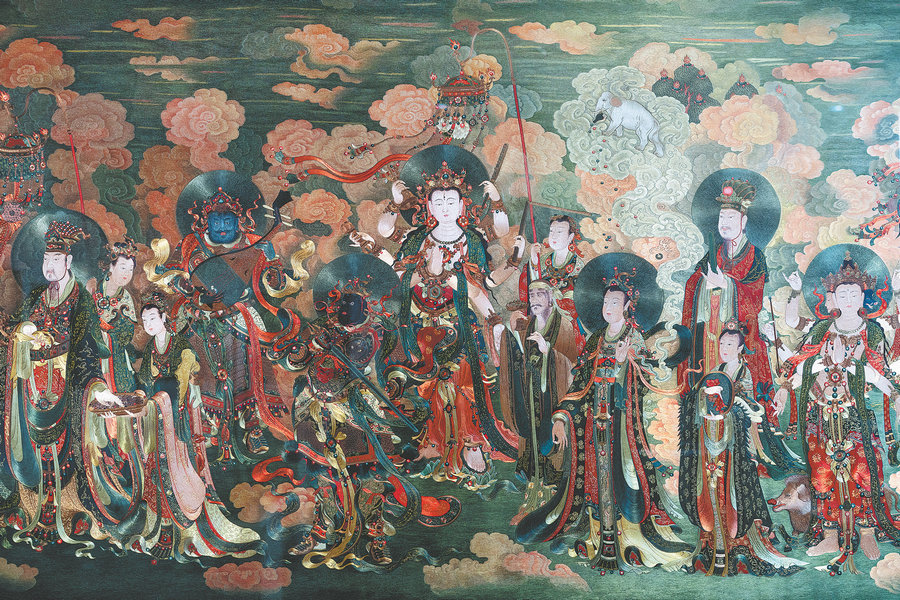
A group portrait of Buddhist deities, several meters in length, is based on a mural and made by Zhang Fan's team using more than 20 stitching techniques of Su embroidery. [Photo provided to China Daily]
In a meters-long mural depicting a group of Buddhist deities, Zhang Fan and his mother used more than 20 stitching techniques, as well as countless colors of various shades. It took them six years to finish.
Zhang Fan says that his mother is always on a path seeking innovation and creativity. She was a deputy director of the Suzhou Silk Embroidery Research Institute, where lots of modern Su embroidery masters were trained and worked.
Last century, embroiderers from the institute learned the realism style from the West and blended it into their works, enabling them to produce photo-realistic work.
Zhang Meifang led the team charged with developing new techniques for Su embroidery. After she retired, with the help of her son, she focused her efforts on developing the traditional craft. The final mission is to integrate it with people's prevailing artistic tastes. They have worked with artists across the globe and their pieces are collected by museums and art institutions both at home and abroad.
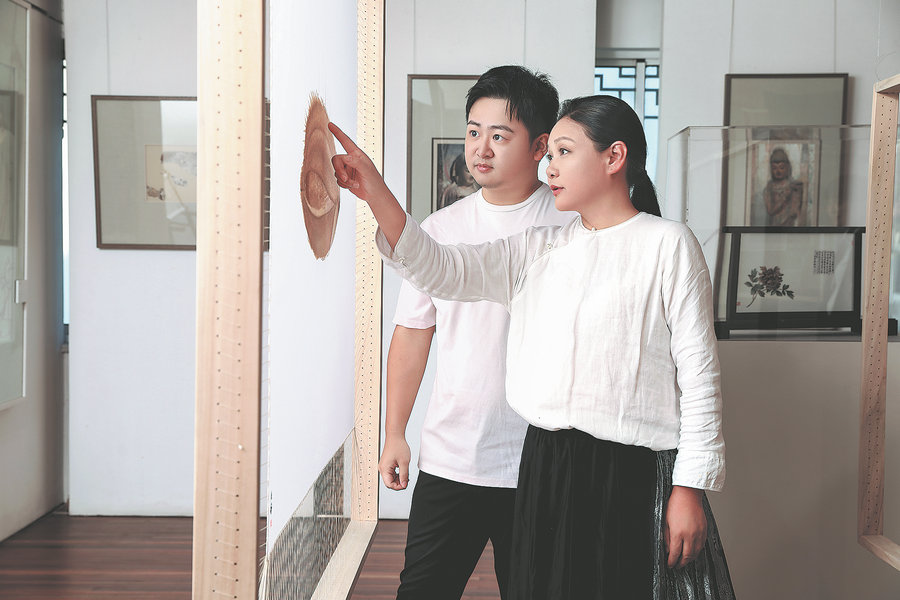
Zou collaborates with her son, Guo Zizhou, in the creation of an embroidery work. [Photo by Gao Erqiang/China Daily]
While the Zhang family tries to explore a modern artistic expression of the centuries-old craft, the younger generation, like Guo Zizhou, 27, is using a popular method to introduce young people to Su embroidery.
Born into a family where all the women are good at Su embroidery, in 2019, Guo opened a themed coffee shop in Suzhou. The latte art comes from patterns frequently used in Su embroidery, such as birds, flowers and trees.
Guo displays many of his mother's embroidery works at the coffee shop and, sometimes, they will hold classes in Su embroidery and invite customers to try the stitching techniques.
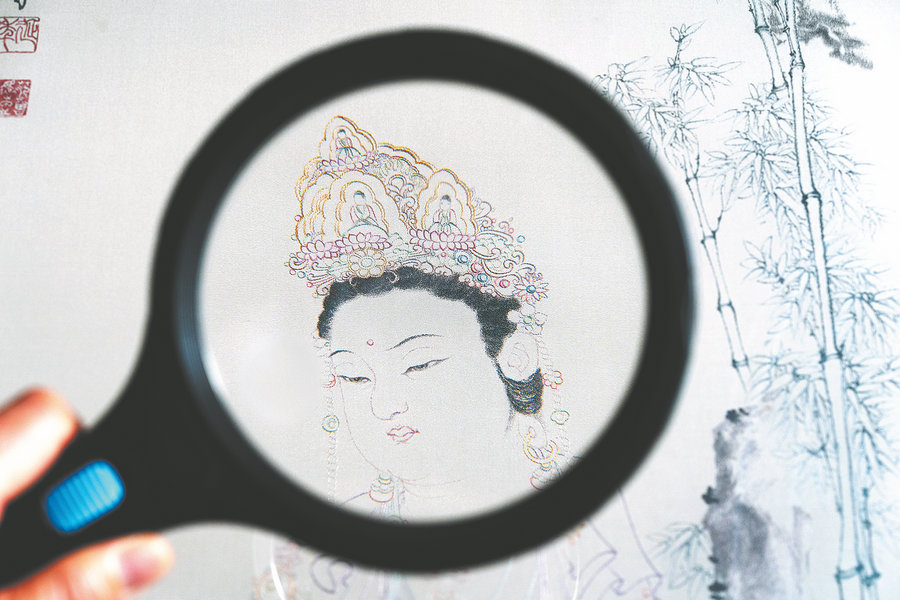
Details of a Buddha embroidery work at Zou Yingzi's studio can only be seen clearly with a magnifying glass. [Photo by Gao Erqiang/China Daily]
Guo is now learning Su embroidery from his mother, Zou Yingzi, whose works are collected by renowned institutions, including the British Museum. Traditionally, Su embroidery is learned by women and passed down among the female members of a family. Guo is one of the few male exceptions.
"My friends all think what I do is chic and cool," says Guo in front of an embroidery stand, moving his needle fluidly through a piece of landscape embroidery.
Guo learned interior design in Britain and earned his master's degree in art in the United States. Only after he returned to China did he decide to inherit the Su embroidery craft from his mother.
Since childhood, the needle has been a common item in his life. Every day he saw his grandmother, his mom and her friends engrossed in Su embroidery.
"When I was a little boy, the needle was an item that could hurt my fingers. Now it has become a tool for me to continue the artistic mission of my family. I find that incredible," says Guo.
In the past few years, Guo has participated in his mother's team to produce large-scale Su embroidery works, two of which were collected by the China National Archives of Publications and Culture.
Each piece stands more than 3 meters high and is 1 meter long, featuring feitian (flying deities) and a traditional building that houses Buddhist sutras, derived from murals at the Mogao Caves in Dunhuang.
Guo helped his mother to finish the two art pieces, which took more than 100 embroiderers several months to produce.
"Without his help, I couldn't have finished the two large pieces. I'm proud of my son. He often gives me fresh and interesting ideas to create innovative Su embroidery works," says Zou.
The son adds that his ideas often collide with his mother's.
In Zou's 24 Solar Terms series, Guo often provides ideas on how to present the theme in a contemporary way. For instance, in the work Guyu (Grain Rain), Guo designed a giant grain while his mother planned to stitch the grains to scale.
Finally, Zou took her son's design, and believes that the piece turned out "amazing".
"I hope the craft can become more integrated into people's daily lives, rather than just being displayed as a decoration or art piece," Guo says.
Related articles
-
 China hosts over 1,800 economic, trade exhibitions in 2022
China hosts over 1,800 economic, trade exhibitions in 2022More
-
 New art center's inaugural show a salute to Chinese expressionism
New art center's inaugural show a salute to Chinese expressionismMore
-
 Art exhibition on Malaysia's cultural heritage tightens ties with China
Art exhibition on Malaysia's cultural heritage tightens ties with ChinaMore
-
 Exhibition on TCM culture held in Beijing
Exhibition on TCM culture held in BeijingMore
-
 2023 Lebanon International Book Fair held in Beirut
2023 Lebanon International Book Fair held in BeirutMore
-
 Jewelry exhibition shines at festival opening
Jewelry exhibition shines at festival openingMore
